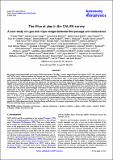Por favor, use este identificador para citar o enlazar a este item:
http://hdl.handle.net/10261/110062COMPARTIR / EXPORTAR:
 SHARE SHARE
 CORE
BASE CORE
BASE
|
|
| Visualizar otros formatos: MARC | Dublin Core | RDF | ORE | MODS | METS | DIDL | DATACITE | |

| Título: | The Mice at play in the CALIFA survey. A case study of a gas-rich major merger between first passage and coalescence |
Autor: | Wild, Vivienne; Rosales-Ortega, Fabián CSIC ORCID; García-Benito, Rubén CSIC ORCID ; González Delgado, Rosa M. CSIC ORCID ; Pérez Jiménez, Enrique CSIC ORCID ; Monreal-Ibero, Ana CSIC ORCID; Iglesias-Páramo, J. CSIC ORCID; Márquez, Isabel CSIC ORCID; Sánchez, Sebastián F. CSIC ORCID; Aguerri, J.A.L.; Alonso-Herrero, A. CSIC ORCID; Olmo, Ascensión del CSIC ORCID; Vílchez Medina, José Manuel CSIC ORCID | Fecha de publicación: | 2014 | Editor: | EDP Sciences | Citación: | Astronomy and Astrophysics 567: A132 (2014) | Resumen: | We present optical integral field spectroscopy (IFS) observations of the Mice, a major merger between two massive (≥ 1011 M ·) gas-rich spirals NGC 4676A and B, observed between first passage and final coalescence. The spectra provide stellar and gas kinematics, ionised gas properties, and stellar population diagnostics, over the full optical extent of both galaxies with ∼1.6 kpc spatial resolution. The Mice galaxies provide a perfect case study that highlights the importance of IFS data for improving our understanding of local galaxies. The impact of first passage on the kinematics of the stars and gas has been significant, with strong bars most likely induced in both galaxies. The barred spiral NGC 4676B exhibits a strong twist in both its stellar and ionised gas disk. The edge-on disk galaxy NGC 4676A appears to be bulge free, with a strong bar causing its >boxy> light profile. On the other hand, the impact of the merger on the stellar populations has been minimal thus far. By combining the IFS data with archival multiwavelength observations we show that star formation induced by the recent close passage has not contributed significantly to the total star formation rate or stellar mass of the galaxies. Both galaxies show bicones of high ionisation gas extending along their minor axes. In NGC 4676A the high gas velocity dispersion and Seyfert-like line ratios at large scaleheight indicate a powerful outflow. Fast shocks (vs ∼ 350 km s-1) extend to ∼6.6 kpc above the disk plane. The measured ram pressure (P/k = 4.8 × 106 K cm-3) and mass outflow rate (∼8-20 M· yr-1) are similar to superwinds from local ultra-luminous infrared galaxies, although NGC 4676A only has a moderate infrared luminosity of 3 × 1010 L·. Energy beyond what is provided by the mechanical energy of the starburst appears to be required to drive the outflow. Finally, we compare the observations to mock kinematic and stellar population maps extracted from a hydrodynamical merger simulation. The models show little enhancement in star formation during and following first passage, in agreement with the observations. We highlight areas where IFS data could help further constrain the models. © ESO, 2014. | Descripción: | V. Wild et al. | Versión del editor: | http://dx.doi.org/10.1051/0004-6361/201321624 | URI: | http://hdl.handle.net/10261/110062 | DOI: | 10.1051/0004-6361/201321624 | Identificadores: | doi: 10.1051/0004-6361/201321624 e-issn: 1432-0746 issn: 0004-6361 |
| Aparece en las colecciones: | (IFCA) Artículos (IAA) Artículos |
Ficheros en este ítem:
| Fichero | Descripción | Tamaño | Formato | |
|---|---|---|---|---|
| The Mice at play.pdf | 2,9 MB | Adobe PDF |  Visualizar/Abrir |
CORE Recommender
SCOPUSTM
Citations
42
checked on 21-abr-2024
WEB OF SCIENCETM
Citations
37
checked on 28-feb-2024
Page view(s)
315
checked on 24-abr-2024
Download(s)
220
checked on 24-abr-2024
Google ScholarTM
Check
Altmetric
Altmetric
NOTA: Los ítems de Digital.CSIC están protegidos por copyright, con todos los derechos reservados, a menos que se indique lo contrario.
